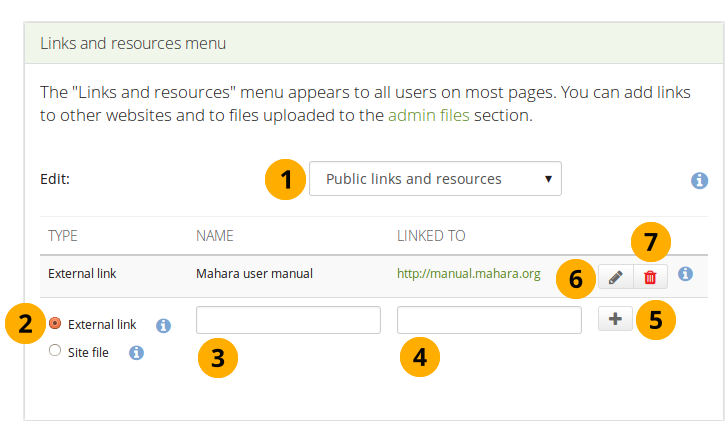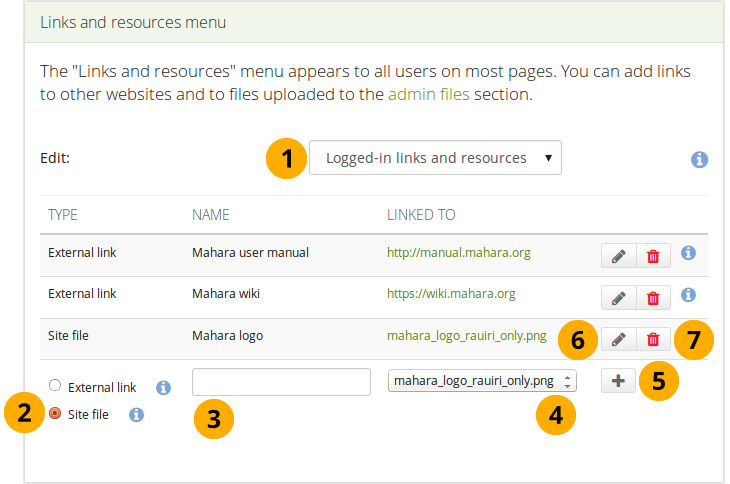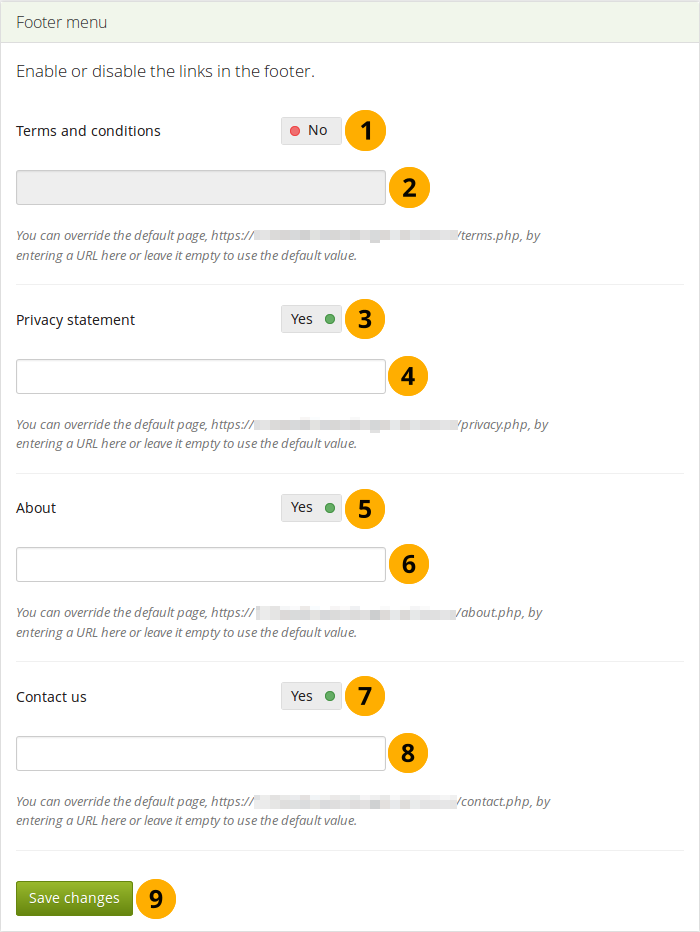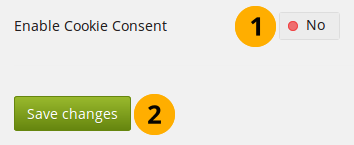10.3. Configure site¶
Administration → Configure site
Note
Configure site is only accessible by site administrators.
In Configure site you can:
set general parameters for your Mahara site
edit site pages
determine the display of certain menu items
allow networking with Moodle or another Mahara
create and share site pages and collections
upload site files
10.3.1. Site options¶
Administration → Configure site → Site options
In Site options you can set global options that will apply by default throughout the entire site.
Note
One or more fields may be disabled if overridden by a setting in your config.php file.
When you are done editing one or more settings, click the Update site options button at the bottom of the page.
10.3.1.1. Site settings¶

Site settings¶
Site name: Choose a name for your Mahara instance. It appears in certain places around the site, e.g. in the title bar of the browser and in emails sent from the site. Therefore, it should not be too long.
Language: Set the default language for your site. If you have multiple language packs installed, you see a drop-down menu. Otherwise, the standard language, English, is displayed.
Note
You can install more language packs. More information about the language packs is on the wiki.
Country: The country selected is the default for country selections throughout your Mahara installation, e.g. in contact information.
Theme: Mahara comes with a number of themes that you can use. Choose one from the drop-down menu to make it the default theme for your site. If you have institutions set up, they can choose their own theme. You can search for community-contributed themes on the Mahara wiki.
Drop-down navigation: If set to “Yes”, the main Mahara navigation uses a drop-down menu for its subnavigation.
Show homepage / dashboard information: If set to “Yes”, information about Mahara and how it is used is displayed on the homepage for logged-out and on the Dashboard for registered users. Registered users can disable this for their own dashboard. See also Quick links.
Send weekly updates?: If set to “Yes”, your site sends weekly updates to mahara.org with some statistics about your site. See also Register your Mahara site.
10.3.1.2. User settings¶
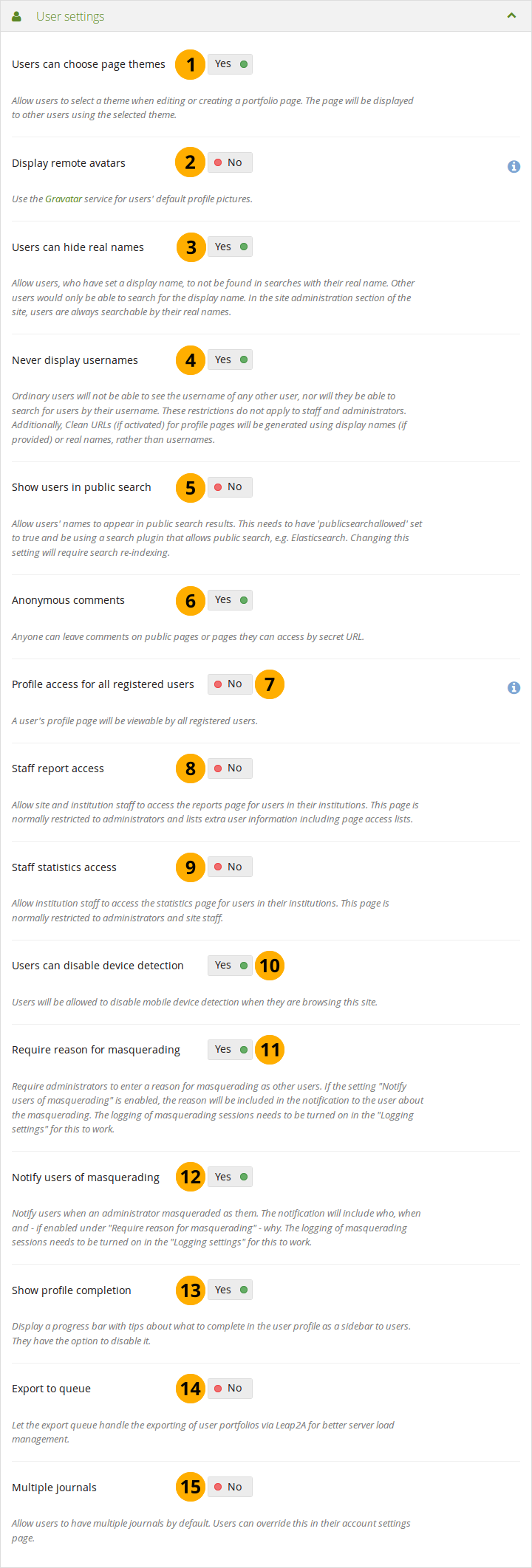
User settings¶
Users can choose page themes: If this setting is enabled, users can select a theme for their portfolio page. The page is displayed with this theme to other users. Thus, the institution or site theme can be overwritten.
Display remote avatars: If allowed, users’ default profile pictures will be their Gravatar pictures (remote avatar). Users will need an account with Gravatar for this to work.
Note
If you use your own avatar server to provide profile pictures for your users, you can use that instead of Gravatar for the default profile pictures. In order to do so, you need to add the remote avatar base URL to your config.php.
Users can hide real names: If allowed, users who have set a display name may choose to be searchable only by their display name and will not be found in searches by their real name. In the administration section of the site, users are always searchable by their real names. An administrator (site and institution) always sees the display name, first and last name and username.
Never display usernames: If set to “Yes”, ordinary users cannot search for others using their username in “Search users” on the Dashboard or via Find people. They will also not be able to see the username of any other user. These restrictions do not apply to staff and administrators. Additionally, Clean URLs (if activated) for profile pages will be generated using display names (if provided) or real names, rather than usernames.
Show users in public search: If allowed, usernames can appear in public search results. In addition, this feature needs to have the value <single: config.php; publicsearchallowed>
$cfg->publicsearchallowed = true;set in your config.php file and requires a search plugin that allows public search, e.g. Elasticsearch.Note
When you change this setting, you need to re-index the search index for the change to take effect.
Anonymous comments: If allowed, logged-out users / users without a login can leave comments on public pages or pages they can access via a secret URL.
Profile access for all registered users: If this option is set to “No”, profile pages are initially viewable by all registered users, but the owner is allowed to restrict access to their institution only if they wish. Enable this option if you want to make sure all users can see each others’ profile pages. Profiles of institution members will always be visible to other members of the same institution.
Staff report access: If set to “Yes”, institution staff will have access to the reports page for users in their institutions. This page is normally restricted to administrators and lists extra user information including page access lists.
Staff statistics access: If set to “Yes”, institution staff will have access to the statistics for users in their institutions. This is normally restricted to administrators and site staff.
Users can disable device detection: If allowed, users can disable mobile device detection in their account settings. This allows them to be more flexible in what they can view and do on a mobile device such as a smartphone or tablet.
Require reason for masquerading: If set to “Yes”, administrators will be required to enter a reason for masquerading as other users. This will be logged, and if the setting “Notify users of masquerading” is enabled, included in the notification to the user about the masquerading. This setting needs logging to be turned on.
Notify users of masquerading: If set to “Yes”, users will be notified when an administrator masqueraded as them. The notification will include who, when and - if enabled under “Require reason for masquerading” - why. This setting needs logging to be turned on.
Show profile completion: If set to “Yes”, a progress bar with tips about what to complete in the user profile will be displayed in the sidebar to users. They can disable it in their :ref`account settings <general_account_options>`.
See also
Administrators can configure the items that count towards profile completion in Administration → Institutions → institution administration.
Export to queue: If allowed, the export queue will handle the exporting of user portfolios via Leap2A for better server load management.
Note
This feature is still experimental. Turning this feature on will export individual portfolios in Portfolio → Export via the export queue. That means that the export is made when there are enough system resources available. The user exporting a portfolio will receive an email when the export is ready for download.
Multiple journals: If allowed, all users will have multiple journals per default. They can still change that setting in their personal account settings.
10.3.1.3. Search settings¶
Mahara comes with a search plugin that allows you to search for users and pages. If you install another search plugin, you will be able to select which one to use for your site.

Search settings¶
See also
You can configure the internal search plugin in the administration of the search plugin.
10.3.1.4. Group settings¶
Mahara cannot only be used for individual work but also to work collaboratively in groups. Some settings are available in that area.
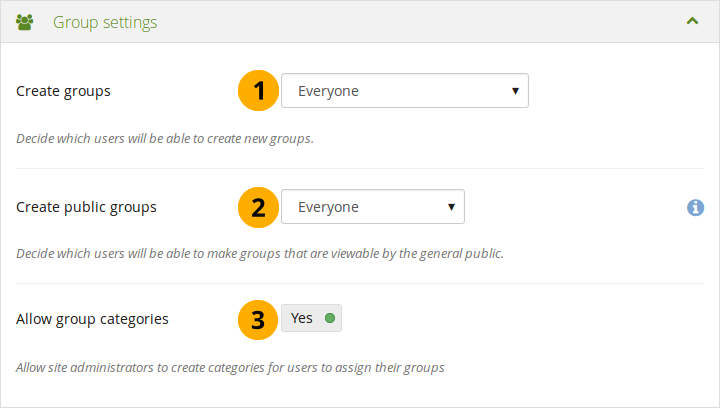
Group settings¶
Create groups: You decide whether administrators, administrators and staff or everyone can create groups. The default setting is the most permissive “everyone” because Mahara is user-centered and gives the individual users a great deal of control over what they want to do. If you choose to limit the group creation to administrators (and staff), these need to be contacted to set up groups. There is no internal group request system.
Create public groups: Choose whether everyone or only administrators can create public groups. These are groups for which you do not need to be a member of the group or even have a login for Mahara to view the group homepage, discussion forums (and member listing if the group administrator allowed that).
Allow group categories: If allowed, site administrators can create categories for users to assign to their groups. These categories can be used to filter groups in My groups and Find groups.
See also
Group categories are managed by site administrators in the groups area of the administration.
10.3.1.5. Institution settings¶
You can use Mahara with multiple institutions and separate them for administrative purposes, e.g. user management and permissions, and to give them a different theme.
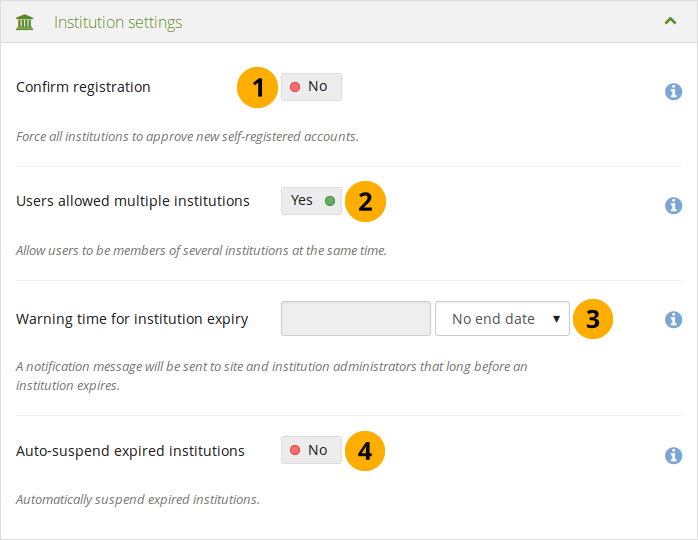
Institution settings¶
Confirm registration: If set to “Yes”, administrators cannot make the Confirm registration setting optional when configuring an institution. This prevents institution administrators from disabling this setting when it is required site-wide to not allow user accounts to be created without administrator approval.
Users allowed multiple institutions: If allowed, users can be members of several institutions at the same time. Thus, a user who belongs to two or more institutions only needs one account.
Note
While this is a convenient setting for people who need to be institution administrators in multiple institutions and cannot receive site administrator permissions, it is recommended that users can only belong to one institution.
Warning time for institution expiry: If set, a notification will be sent to site and institution administrators this amount of time before an institution is due to expire and be suspended. This time may be specified in days, weeks, months, years or “No end date”. If the latter option is chosen, institutions will not expire by default.
Auto-suspend expired institutions: If set to “Yes”, this option will allow Mahara to automatically suspend an institution that has expired automatically. This means that users of that institution will not be able to log in until the institution has been unsuspended.
10.3.1.6. Account settings¶
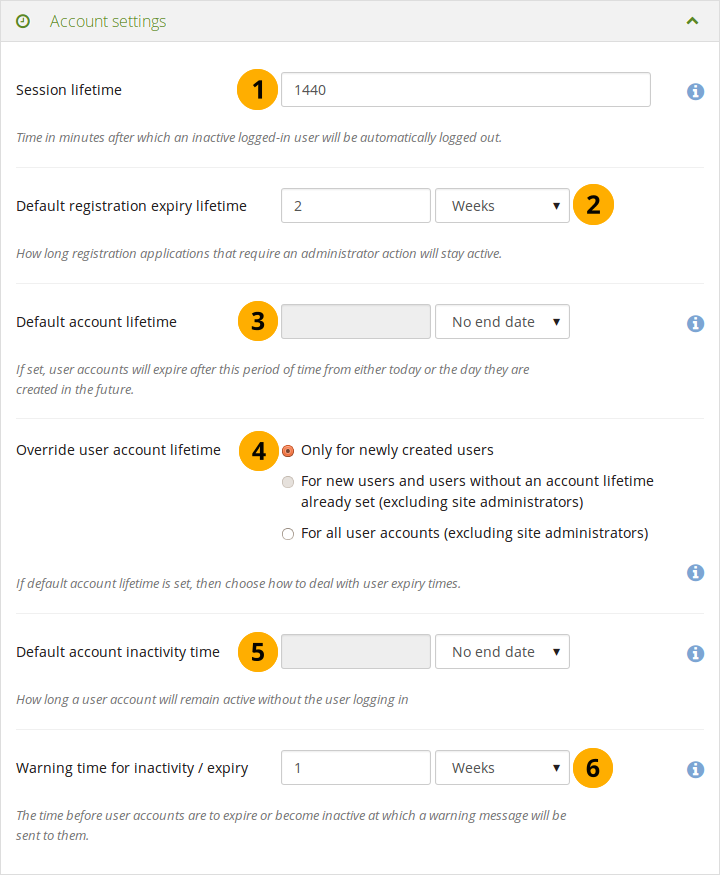
Account settings¶
Session lifetime: For security reasons, after a specified period of inactivity, a user will be logged off the site automatically. This field specifies this time in minutes. The default value is 1440 minutes (24 hours).
Default registration expiry lifetime: As site administrator you can decide when pending registrations that require approval expire. This time may be specified in days, weeks, months, years or “No end date”. If the latter option is chosen, pending registrations will not expire by default. The default value is 2 weeks.
Default account lifetime: If set, user accounts will expire after this amount of time from when they were created. When a user account is expired, the user cannot log in. This time may be specified in days, weeks, months, years or “No end date”. If the latter option is chosen, accounts will not expire by default.
Override user account lifetime: Choose for which accounts a change in the default account lifetime shall take effect:
Only for newly created users
For new users and users without an account lifetime already set (excluding site administrators)
For all user accounts (excluding site administrators)
Note
Site administrators are always excluded from a change in the account lifetime as they should always have access to the system.
Default account inactivity time: If set, users who do not log in for this amount of time will be considered “inactive” and will not be able to log in anymore. This time may be specified in days, weeks, months, years or “No end date”. If the latter option is chosen, users are not set to “inactive” by default.
Warning time for inactivity / expiry: If set, a warning message will be sent to users this amount of time before their accounts are due to expire or become inactive. This time may be specified in days, weeks, months, years or “No end date”. If the latter is chosen, users do not receive a warning before their account expires or they are flagged as having an inactive account.
10.3.1.7. Security settings¶
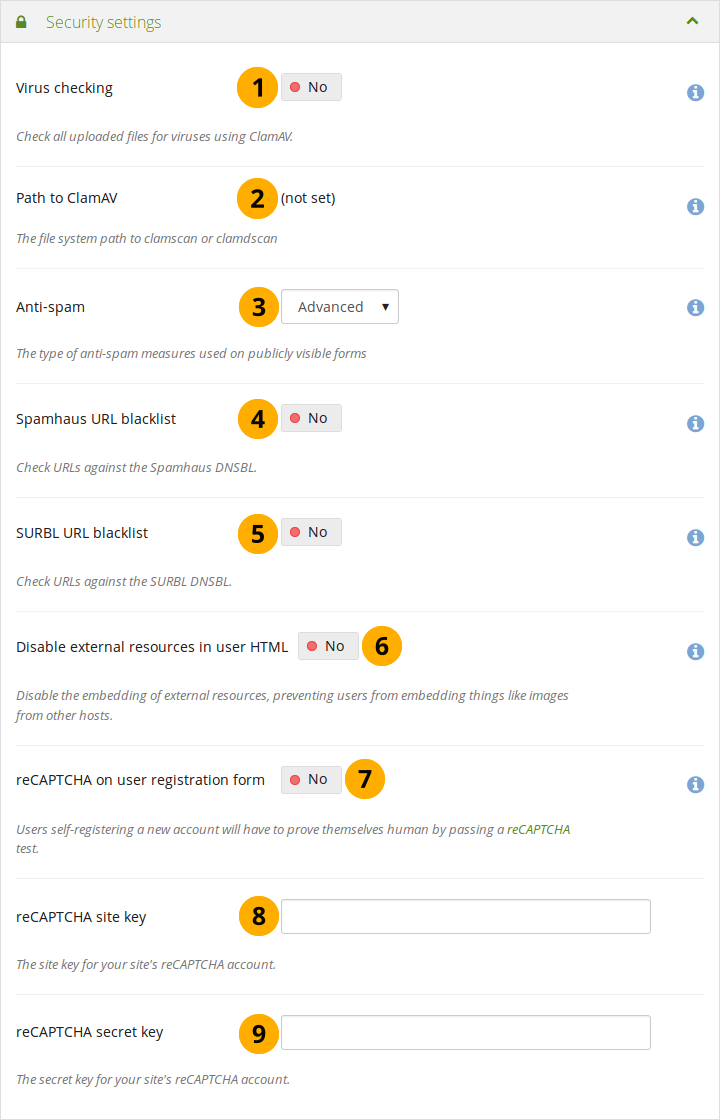
Security settings¶
Virus checking: If you want all files that are uploaded by users to be run through the ClamAV virus scanner, you should turn the virus checking option on. You have to have ClamAV installed on your server.
Path to ClamAV: For security reasons, the path to ClamAV on your server needs to be provided in the config file. You see the path here if you provided that config value.
Anti-spam: There are three levels of anti-spam protection available for publicly visible forms such as the contact and registration forms. A form submission is never silently rejected. Rather, an error message is displayed asking the user to try again if the submission is classified as spam. The three choices are:
None: No anti-spam checks are performed on form submissions.
Simple: Some basic checks are performed. Form submissions with email addresses that are not well-formed or that have an excessive number of URLs are rejected.
Advanced: Performs additional checks to determine whether email addresses are real or contain URLs that are blacklisted. This requires an Internet connection.
Spamhaus URL blacklist: If set to “Yes”, URLs will be checked against the Spamhaus DNSBL. The Spamhaus Project provides a URL blacklist that is free for non-commercial, low-traffic use. A professional use datafeed service is also available but not supported in Mahara. Please read the Spamhaus DNSBL usage terms before enabling this option.
SURBL URL blacklist: If set to “Yes”, URLs will be checked against the SURBL DNSBL. SURBL provides a URL blacklist that is free for organizations with fewer than 1000 users. A professional use datafeed service is also available, but not supported in Mahara. Please read the SURBL usage terms before enabling this option.
Disable external resources in user HTML: Turning this option on will prevent users from embedding external resources such as images from remote sites into their forum posts and other HTML content. YouTube videos and other media can also not be embedded. It is however a good thing to do from a security standpoint since it does neutralise a few clever phishing attacks. See the HTML Purifier documentation for more details.
reCAPTCHA on user registration form: If set to “Yes”, people who register themselves on the site are required to fill in a reCAPTCHA test. This is a spam protection instrument.
reCAPTCHA site key: Enter the site key for your site’s reCAPTCHA account.
reCAPTCHA secret key: Enter the secret key for your site’s reCAPTCHA account.
10.3.1.8. Proxy settings¶
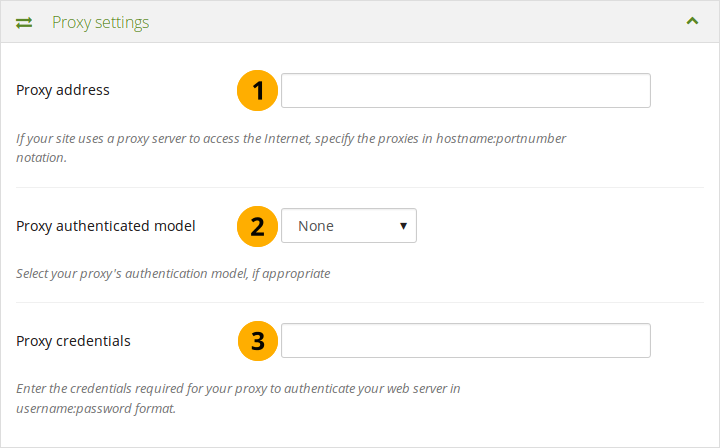
Proxy settings¶
Proxy address: If your site uses a proxy server to access the Internet, specify the proxy in
hostname:portnumbernotation.Proxy authentication model: Select your proxy’s authentication model (none or basic [NCSA]), if appropriate.
Proxy credentials: Enter the credentials required for your proxy to authenticate your web server in
username:passwordformat.
10.3.1.9. Email settings¶

Email settings¶
SMTP host: If you want to force Mahara to use a specific SMTP server instead of the system one, enter its hostname here, e.g.
smtp.example.com. It is possible to specify more than one host by separating them with semicolons, e.g.smtp1.example.com;smtp2.example.com, but keep in mind that all other settings, e.g. authentication credentials and port numbers, will apply to all listed servers. It is not possible to specify different credentials for each server in this list. This feature is useful when SMTP host authentication is not required or you list different frontends for the same mail server in which case other settings will work.SMTP port: If your SMTP server uses a port number different from 25, you may specify it here. When encryption is enabled, the default ports are 465 for SSL and 587 for TLS. You only need to specify a port number if it is different from these. Check the correct settings with your mail service provider.
User: If your SMTP server requires authentication, enter the username here.
Password: If your SMTP server requires authentication, enter the password here.
SMTP encryption: If your SMTP server supports encryption, enable it here.
System mail address: This email address is the address that emails are sent from Mahara.
10.3.1.10. Notification settings¶
You can set the default options for new users to receive notifications. Users can override these settings on their own Settings → Notifications page.
The options you have are:
Email: Sends an email to your primary email address once the notification was created. In some cases, the cron needs to run first in order for the notification to be sent.
Email digest: Sends one email per day for all the notifications that you set to “Email digest”.
Note
If you select either of the email options, notifications will still arrive in the user’s inbox, but they will be marked as read automatically.
Inbox: All notifications are only sent to your system inbox that you can reach in the top right corner next to the “Logout” button.
None: If you use this option, you will not get a notification for the selected notification type. Use this setting wisely as you may miss important notifications.
Note
You cannot set “System messages” and “Messages from other users” to “None”.

Notification settings¶
Contact us: Only site administrators see this notification type. These are messages sent via the “Contact us” form that can be accessed in the footer of the site if the site administrators decided to display this link.
Feedback: These are notifications about any comments received on pages, artefacts or journal posts.
Feedback on annotations: These notifications are triggered when feedback is left on an annotation.
Group message: The system generates these notifications automatically, e.g. when a user requests to join a group.
Institution message: These notifications are generated by the system automatically, e.g. institution confirmation message, institution removal message, institution request sent to administrator.
Message from other users: Messages that are sent by other users.
New forum post: These notifications are sent to a user when new forum posts happened in the forums or forum topics that the user is subscribed to.
New page access: This type of notification is sent to you when you, you as a friend or one of your groups has been given access to a page. You do not receive notifications about pages accessible to all registered users and the public.
Objectionable content: Only administrators see this notification type. These notifications contain complaints by users about content that an administrator should take a look at because it does not comply with the terms and conditions set out for the site. This setting is for pages and artefacts that contain objectionable content.
Objectionable content in forum: Only administrators see this notification type. These notifications contain complaints by users about content that an administrator should take a look at because it does not comply with the terms and conditions set out for the site. This setting is for forum topics and posts that contain objectionable content.
Repeat virus upload: Only site administrators see this notification type. This notification informs site administrators about users who repeatedly upload virus-infected files. Virus checking must be turned on.
System message: This type of notification is generated automatically by the system or sent automatically by one of the site administrators, e.g. account confirmation message.
Virus flag release: Only site administrators see this notification type. This notification lets site administrators know when files were released by the virus scanner. Virus checking must be turned on.
Wall post: This type of notification is sent to you when somebody else leaves a public or private message on your wall.
Watchlist: Notifications of updates to pages or artefacts that you put onto your watchlist are generated automatically and sent in intervals.
10.3.1.11. General settings¶

General settings¶
Allow public pages: If set to “Yes”, users can create portfolio pages that are accessible to the public rather than only to registered users.
Allow public profiles: If allowed, users can set their profile pages to be accessible to the public rather than only to registered users. However, only registered users can use interactive features such as the wall.
Note
If the option “Allow public pages” is chosen, “Allow public profiles” is automatically selected.
Allow anonymous pages: If set to “Yes”, users can hide their name as the author of a page from other users. Administrators and staff can still view authorship information by clicking on the “Author’s name hidden” link that will reveal the real name.
Sitemap: If set to “Yes”, sitemap files from publicly accessible pages, groups and forum topics are generated that can be sent to another service.
Portfolio search: If allowed, the “Search my portfolio” side block is displayed in the Content and Portfolio sections of the site. However, it has not been working for most users for a long time.
Tag cloud: If set to “Yes”, users see a side block in the Content and Portfolio sections of the site with a list of their most frequently used tags. The number of tags displayed is defined by the option “Maximum tags in cloud”.
Maximum tags in cloud: Enter the default number of tags to display in user tag clouds. Users can change this number in their account settings.
Show online users: If set to “Yes”, users see a side block with a list of the users who have been logged-in in the last 10 minutes (cf. the dashboard). Institution administrators can limit the users displayed in this block to institution members in the institution settings.
Online users limit: Enter the maximum number of users to display in the Online users side block.
Registration agreement: If set to “Yes”, you force users to agree to the “Terms and Conditions” before registration. You should edit your site’s “Terms and Conditions” page before enabling this option. You can do so under Static pages.
License metadata: If allowed, users can choose under which license they want to make their content available. They can set a default license in their account settings and then decide for each artefact individually as well. An institution administrator can set the default license in the institution settings.
Custom licenses: If allowed, users can enter any URL as license for their content. If not checked, users will be limited to the licenses configured by the site administrator.
Mobile uploads: If set to “Yes”, users have the option of setting authentication tokens in their account settings. That allows them to upload content from their mobile devices. You can enter more than one token in order to connect mutliple mobile devices.
HTML editor: Choose whether the HTML editor is used by default or not. If set to User-defined, users will be allowed to choose whether to use the HTML editor in their personal settings or not. Otherwise the specified setting will be used site-wide.
Enable MathJax: If set to “Yes”, mathematics and science equations can be displayed nicely in Mahara pages. For more information on how to configure MathJax, see the Help icon next to the option.
Access to site files: If allowed, registered users will have access to site files in subfolders of the folder “public”. By default, only files directly in the folder “public” are accessible to them.
Watchlist notification delay: Decide how many minutes after editing a page, a watchlist notification is sent. The default value is “20” for 20 minutes.
Note
In the past, a watchlist notification about a change was sent whenever a block was edited on a page. Since that caused a lot of notifications to be sent, a delay has been put in place to accumulate a number of changes so that it can be assumed more that a page and not only an item on the page has changed.
10.3.1.12. Logging settings¶
Mahara logs a number of events. These can now be collected in the database as well. The primary reason for logging events in the database is the logging of administrators masquerading as users for enhanced audits of these actions.
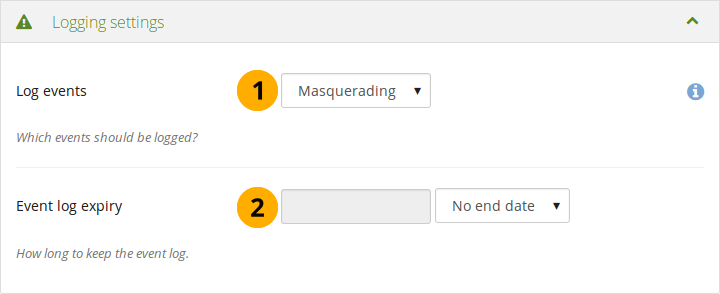
Logging settings¶
Log events: Decide which events you wish to log in the database. Events are generated every time the user does something significant on the site, such as editing a page. This log is kept in the
event_logtable in the database.None: Nothing is logged in the database.
Masquerading: Only masquerading sessions are logged. This setting needs to be turned on if you wish to report on administrator masquerading.
All: All events that can be logged in the database are logged.
Note
No matter which logging setting you choose, all events are still logged in the access log.
Event log expiry: Decide for how long you wish to keep your database log. If you selected to log all events, the table can grow quite quickly especially on an active site. This time may be specified in days, weeks, months, years or “No end date”. If the latter option is chosen, the event log is not deleted by default.
See also
A report of masquerading sessions is available in the “User reports” section if you turned on logging of masqueraded session or all logging.
The table event_log contains the data that can be logged:
usr: user ID of the person whose account is shown on screen
realusr: user ID of the administrator who masquerades
event: action being carried out, e.g. beginning of a masqueradin session, saving of an artefact, deleting of a page or artefact, update user information, placing a block onto a page
data: additional information about the action, e.g. the ID of a block that is updated
time: time when the action was carried out
10.3.2. Static pages¶
Administration → Configure site → Static pages
Here you can edit the content of some pages around the site and the pages linked to in the footer:
About
Home (Dashboard)
Logged-out home
Privacy statement
Terms and conditions
See also
Institutions can change the content of these pages on their static institution pages to their liking and do not have to go with the content from the entire site.
All pages come with default text that you can change entirely. Every page must contain some text. You can use the visual editor to style your page.
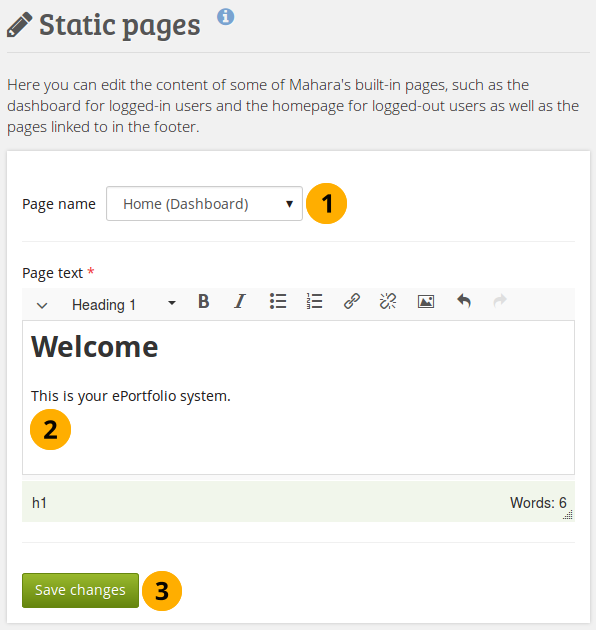
Edit static pages¶
Page name: Choose the page you want to edit from the drop-down menu.
Page text: Change the text in the editor window. You cannot leave this field empty.
Click the Save changes button.
Note
If your site has added custom pages to the menu, e.g. like MyPortfolio.school.nz where you have a number of additional informational pages, you can edit their content from the Static pages screen. In order to do so, a server administrator needs to make changes on the backend.
10.3.4. Networking¶
Administration → Configure site → Networking
Mahara’s networking feature allows it to communicate with other Mahara or Moodle sites. If networking is enabled, you can use it to configure single sign-on (SSO) for users who log in at either Moodle or Mahara or allow users from another Mahara instance to access yours.
You can connect Mahara and Moodle to save certain content you created in Moodle through the portfolio feature.

Networking overview¶
In order to use networking site-wide with any institution, you need to:
Enable networking: Choose “Yes” if you wish to connect one or more Mahara or Moodle sites to your Mahara instance.
Auto-register all hosts: If you choose “Yes”, an institution is created for any host that connects allowing these users to log in to your Mahara site. We recommend you leave the default “No” because that gives you more control over which Moodle or Mahara instances can connect.
Click the Save changes button.
Click the Delete this key button if you want to generate a new key for your Mahara site, e.g. when you copied the database from another site or the other instance doesn’t recognize it properly.
Depending on which site you wish to connect, you may need to provide some of the other information on the page, in particular the WWW root and the public key.
See also
You can consult the comprehensive guide for setting up a Mahoodle when connecting Mahara and Moodle.
You set up MNet for an institution when you edit the authentication method XML-RPC.
10.3.5. Licenses¶
Administration → Configure site → Licenses
The site administrator can allow users to add license metadata to their artefacts in the general site settings. Additionally, an institution administrator can require institution members to choose a license for any of their artefacts in the institution settings.
10.3.5.1. List of licenses¶
Licenses that are available to all users of the site are defined on the Licenses page. Mahara comes with a number of pre-defined licenses, but the site administrator can add many more or delete any of the existing ones.
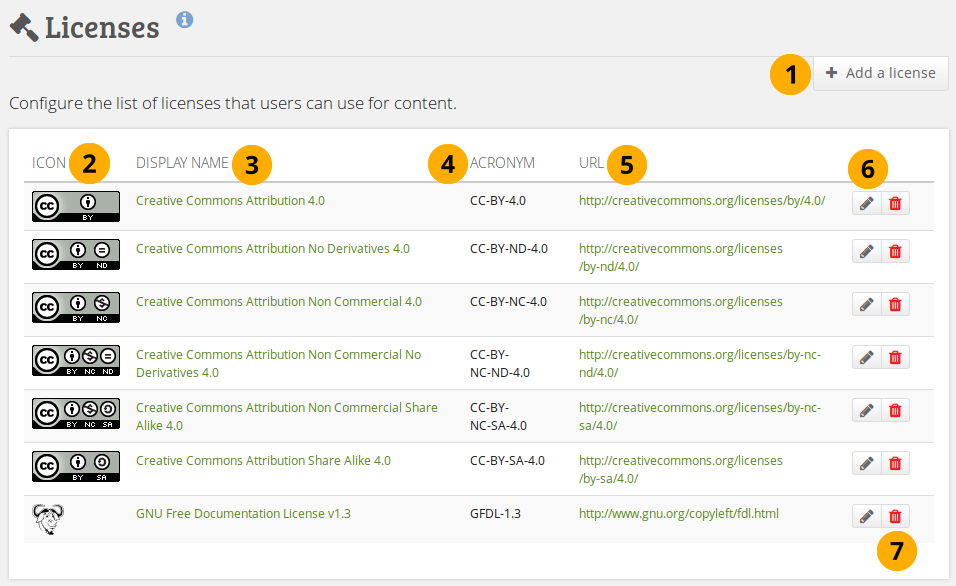
Available licenses on the site¶
Click the Add a license button to add an additional license that users can choose from.
Icon: Every license can have an icon / license logo that is displayed on the details page of an artefact.
Display name: The name that is displayed for each license around the site, e.g. in the drop-down menu where a user can select a license and on the details page of an artefact.
Acronym: The short name by which the license is also known. This acronym is also displayed to the user on the details page of an artefact.
URL: The Internet address where the license text can be found. When a license is displayed on the details page of an artefact, it is linked to this URL.
Note
It is important for users to be able to click on a link to the license because that allows them to learn about the license conditions and what they can do with the artefact or not.
Click the Edit button to change properties of a license. You can change the display name, acronym and the license icon, but not its URL. If you want to change the latter, you will need to create a new license.
Click the Delete button to remove a license from the system.
10.3.5.2. Add a license¶
As site administrator you can add as many licenses as you wish. Go to Administration → Configure site → Licenses and click the Add a license button.
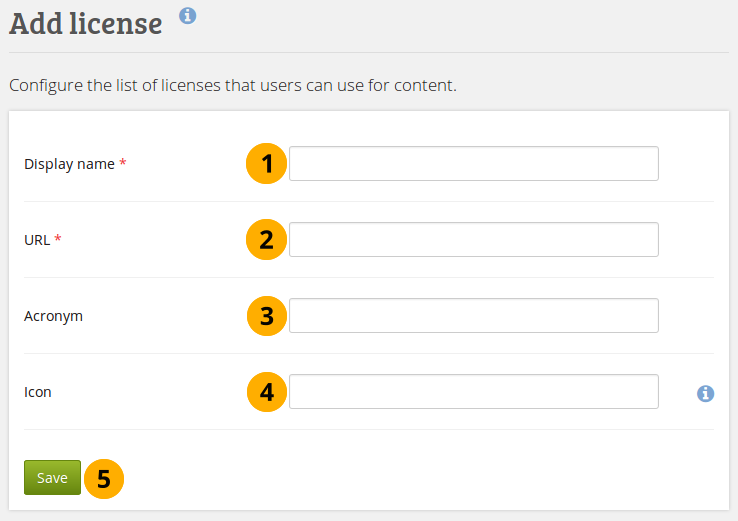
Add a new license to the site¶
Display name: Choose a name for your license that will be displayed around the site, e.g. on the details page of an artefact and in the drop-down menu in which users and institution administrators choose their defaul license. This field is required.
URL: The Internet address where the license text can be found. When a license is displayed on the details page of an artefact, it is linked to this URL. This field is required.
Acronym: If the license you want to add also has a commonly known acronym, you can enter it.
Icon: If the license you add has a logo that you want to display next to the icense, e.g. on the details page of an artefact, you can link it here.
Click the Save button to add the license to the site.
10.3.5.3. Edit a license¶
As site administrator you can change the properties of any license. Go to Administration → Configure site → Licenses and click the Edit button next to a license that you want to change. You can change all license properties but the URL.
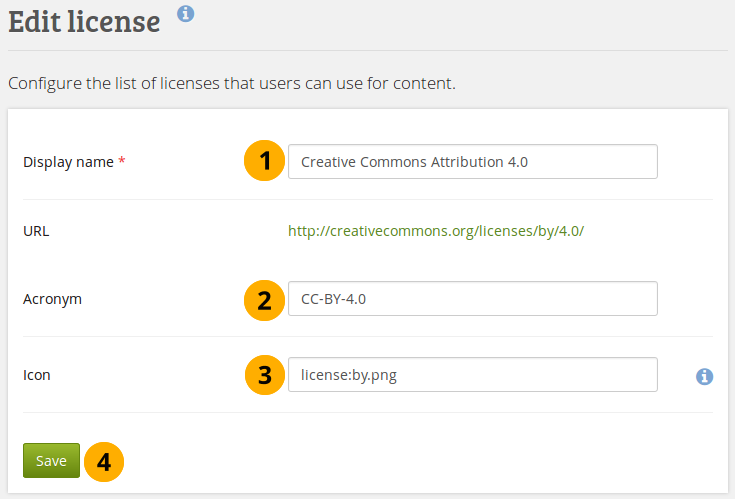
Edit a license on the site¶
Display name: Change the name of the license that is displayed around the site.
Acronym: Change the acronoym of the license.
Icon: Change the icon that is associated with the license and displayed along with the license’s name around the site.
Click the Save button to keep your changes to the license.
Note
You cannot change the URL of the license. If you have a mistake in the URL, you will need to delete the license entirely and add it correctly.
10.3.6. Site pages and collections¶
Administration → Configure site → Pages and collections
You can create site pages with informational content to share with other users or you can create templates which users can copy into their own accounts. You can also change the default content and layout of the pages for the dashboard, profile, group homepage, and regular page.
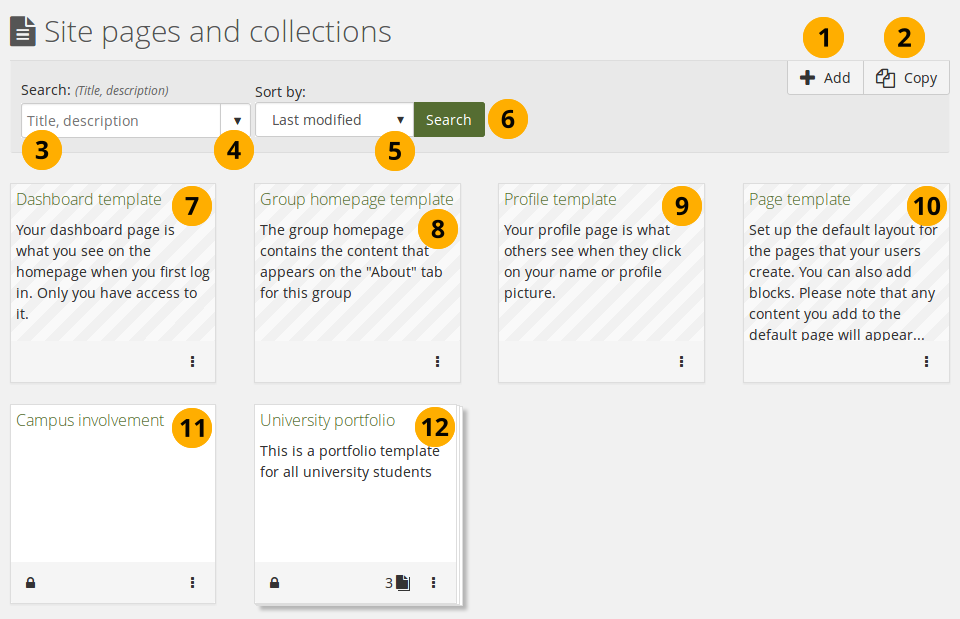
Site pages and collections¶
Adding and editing site pages and collections is very similar to creating and editing a portfolio page or collection. However, not all blocks are available when editing a site page in the page editor due to the different context. Please refer to the overview of blocks for a list of all the blocks that you can use in a site page.
Click the Add button to start a new page or collection from scratch.
Note
A modal opens in which you can choose whether to create a page or collection.

Click the Copy button to choose an existing page or collection as basis.
Search: Type your search term into the search field.
Use the drop-down arrow to limit your search. The available options are:
Title, description, tags: Search for your search term in the title, descirption, and tags of your site portfolios.
Title, description: This is the default option. It searches in the title and description of your site portfolios.
Tags: Search only within the tags of your site portfolios.
Sort by: Decide on the sort order in which you wish to display your portfolios.
Alphabetical: Portfolios are displayed in alphabetical order.
Date created: List the portfolios in chronologically reverse order with the newest portfolios first.
Last modified: Display the portfolios in the order of their last modification with the most recent portfolios that have been changed first. This is the default display option.
Last viewed: Show the portfolios in the order in which they were viewed by you and others starting with the most recently viewed portfolios.
Most visited: Display the portfolios that have been visited most first in the list.
Most feedback: List the portfolios in descending order based on the amount of feedback they have received.
Note
The sort order that you choose does not change when you navigate away from the overview page or log out. When you change the sort order, that new setting will be used until you change it again.
Click the Search button to search your site portfolios based on your search term and / or sorting criteria.
Dashboard template: You can edit the dashboard template. The dashboard doesn’t change for existing users. However, new users will get the changed dashboard.
Group homepage template: Change the layout and the blocks that are displayed on all group homepages. This only affects groups created after the changes.
Profile template: Make changes to the layout and the blocks that users see on their profile page per default. Your changes only affect new users.
Note
You cannot delete the dashboard, group homepage, profile and page templates.
Page template: Change the default portfolio page. The changes only affect any pages that are created after you made the change.
Note
Changing this page template is useful if you want to have all new pages use a specific layout instead of the built-in three-column layout. You could also place a block onto the template that any new page should have.
Users still have the possibility to change any settings once they create their page. You are not locking them into a specific way.
Once you are done creating your site portfolios, you can share them with others.
Note
When somebody leaves feedback on a site page or artefact, the site administrators receive a notification.
10.3.7. Site journals¶
Administration → Configure site → Journals
You create site journals like regular user journals.

Site journals¶
You can create multiple journals. Click the Create journal button to set up a new journal.
All your journals are listed on Administration → Configure site → Journals with their titles. The titles link through to the individual journals.
You can see the description of the journal.
You see how many entries you have in each journal.
Click the Arrow icon to be taken to the journal and see all journal entries.
Click the New entry button to create a new journal entry directly from this screen.
Click the Edit button to make changes to your journal title, description or tags.
Click the Delete button to delete the journal and all its entries.
Warning
When you click the Delete button, you receive a confirmation message whether you really want to delete the journal or not. If you used the journal or an entry of it in a page, Mahara lets you know so you can decide whether to delete the journal or not. Once you agree to delete the journal, your journal and all its content are removed permanently.
10.3.9. Site skins¶
Administration → Configure site → Site skins
Warning
Skins is a feature that can be applied on top of themes for pages. While you can change a lot of style elements, changing all of them is not advised depending on the theme that is underlying your page.
This feature is only available when the server administrator enabled skins for the site.
You can create skins that will be available to all users of your site.
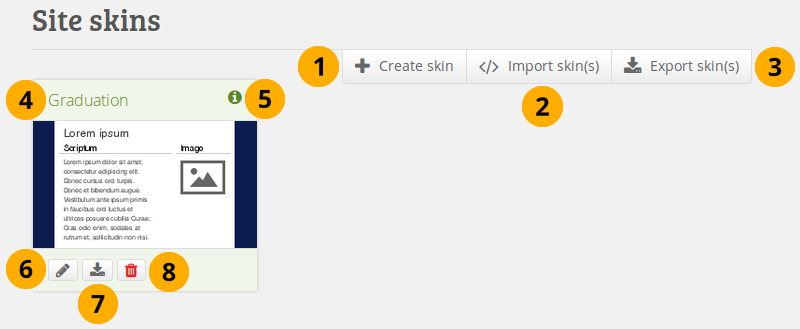
Site skins¶
Click the Create skin button to design a new skin.
Click the Import skin(s) button to import skins that others have shared online.
Click the Export skin(s) button to export all site skins.
The title of the skin.
Click the Info button to see more details for the skin, e.g. who created it when.
Click the Edit button to make changes to this skin.
Click the Export button to export only this one skin.
Click the Delete button to remove this skin.
See also
The process of creating and editing a site skin is very similar to creating and editing skins in your portfolio.
10.3.10. Fonts¶
Administration → Configure site → Fonts
You can install additional fonts to be used with page skins. Currently, you cannot use these fonts anywhere else.
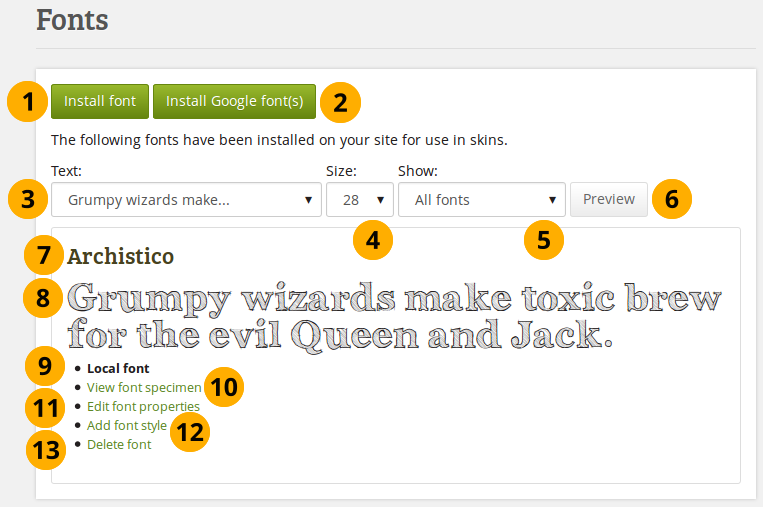
Fonts overview page¶
Click the Install font button to install a font from your computer.
Click the Install Google font(s) button to install fonts you discovered through Google fonts.
Text: Decide in which preview text the installed fonts should be displayed on this overview page. The default text is “Grumpy wizards…”:
Latin alphabet (ASCII only)
Latin alphabet (ISO/IEC 8859-1)
Latin alphabet (ISO/IEC 8859-2)
Cyrillic alphabet (ISO/IEC 8859-5)
Greek alphabet (ISO/IEC 8859-7)
Numbers and fractions
Punctuation
Lorem ipsum dolor sit amet, consectetur adipiscing elit.
Grumpy wizards make toxic brew for the evil Queen and Jack.
The quick brown fox jumps over the lazy dog.
Note
Not all fonts have the full character set implemented. In particular, the Cyrillic and Greek alphabets may be missing and also some numbers, fractions and pucntuation symbols.
The three last sentences show most / all of the letters in the English alphabet.
Size: Decide on the size of the letters in which the installed fonts should be displayed on this overview page. The default size is 28.
Show: Decide which fonts you want to see on this overview page:
All fonts
Local fonts
Google web fonts
Click the Preview button to change which fonts are displayed depending on the criteria you selected.
The title of the font is shown.
See what your font looks like according to your preview settings.
You see whether it is a Google font or a local font that you uploaded.
Click View font specimen to see details about this font.
Click Edit font properties on a local font to change some font settings.
Click Add font style to add more styles for a local font.
Click Delete font to delete this font.
10.3.10.1. Install a local font¶
You can install a font that you find online as long as you have the permission to do so. Please always read the license of a font before uploading it to ensure that you are allowed to do so.
See also
There are a lot of websites for finding fonts. One of them where you can use, share and remix them is the Open Font Library.
Click the Install font button on the Fonts overview page.
See also
If you want to upload a font you found on Google fonts, please follow the Google fonts installation instructions.

Install a font¶
Font name: Provide the name of the font. this field is required.
Font notice: Provide information about the font, e.g. license, and the font creator.
Font style: State what styles the font has available that you upload. If the styles come in separate font files, you need to upload all of them separately:
Regular
Bold
Italics
Bold italics
Font type: Decide where in a page skin the font can be used:
Headings and text
Headings only
Generic font family: To what generic font family does this font belong? Choose from:
serif: Letters and symbols have a small line attached to the end of a stroke to guide the eye from one letter to the next. An example is the font “Times New Roman”.
sans-serif: Letters and symbols do not have the guiding line. An example is the font “Arial”.
monospace: All letters have the same space.
cursive: Handwriting fonts.
fantasy: Fonts that are very ornamented.
ZIP archive: You can upload all font files in one go using a zip archive instead of having to upload them separately. You need to include all required font files.
Font files: You need to upload your font in all these font files in order to ensure that it can be displayed in different browsers and on different devices. Click the Browse button next to each font file type to upload that specific font file.
EOT font file: Embedded OpenType font (for Internet Explorer 4+)
SVG font file: Scalable Vector Graphic font (for iPad and iPhone)
TTF font file: TrueType font (for Firefox 3.5+, Opera 10+, Safari 3.1+, Chrome 4.0.249.4+)
WOFF font file: Web Open Font Format font (for Firefox 3.6+, Internet Explorer 9+, Chrome 5+)
License file: Upload the font license file
See also
You can use the FontSquirrel Webfont Generator to convert your fonts into the required formats.
Click the Install font button to finish installing this font or click Cancel to abort your action.
10.3.10.2. Edit a local font¶
You can make certain changes to a local font and also install additional font styles.
Click Edit font properties on the Fonts overview page to make changes to a number of settings of a local font.
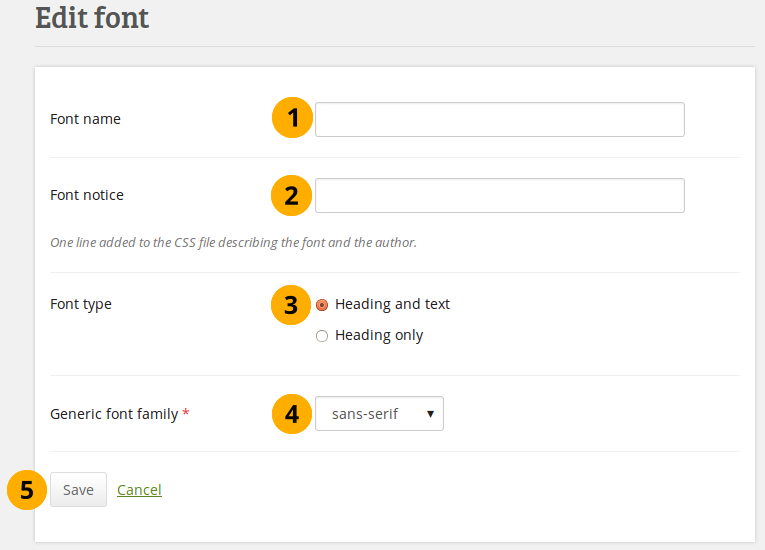
Edit font properties of a local font¶
Font name: Edit the font name.
Font notice: Make changes to the license information and the creator of the font.
Font type: Choose whether the font can be used for headings only or also for regular text.
Generic font family: Change the font family to which this font belongs.
Click the Save button to accept your changes or click Cancel to abort your action.
Click the Add font style button to upload additional font styles for your font. If your font comes with a number of different styles in separate files, you need to upload them separately.
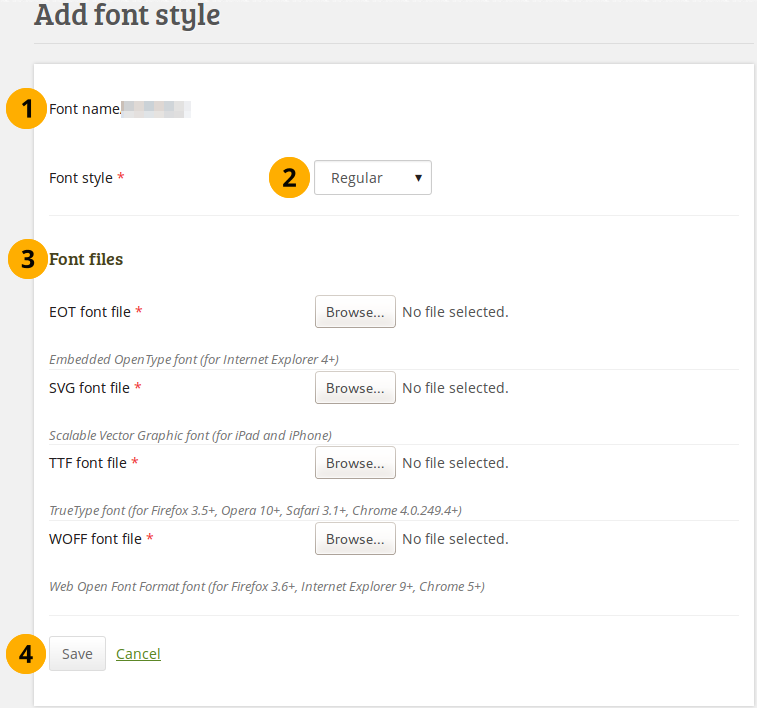
Add an additional font style to a specific font¶
Font name: The name of your font for which you are uploading an additional font style is displayed.
Font style: Choose the font style that you are uploading.
Font files: Upload all required font files.
Click the Save button to accept your changes or click Cancel to abort your action.
10.3.10.3. Install Google font(s)¶
Click the Install Google font(s) button to see the instructions and the font upload area for Google fonts.

Install Google font(s)¶
Follow the instructions for finding and downloading Google fonts.
Visit the Google fonts website.
Select the fonts that you wish to make available for all users to choose for skins and add them to your collection on Google.
Download all fonts as a ZIP file.
Valid ZIP file: Click the Browse button to upload the ZIP file that you downloaded from Google.
Click the Install Google font(s) button to add these fonts to your fonts on Mahara or click Cancel to abort your action.
10.3.11. Files¶
Administration → Configure site → Files
Here you can upload files that you can include in the links and resources menu or in site pages. You can add files that are in the home directory to the menu with resources for logged-in users. Files that you save in the public folder can be used in the menu for users who are not logged-in. Additionally, users can put them into their own portfolio pages as files to download.
See also
The process of uploading and managing files is very similar to files in your personal files area.
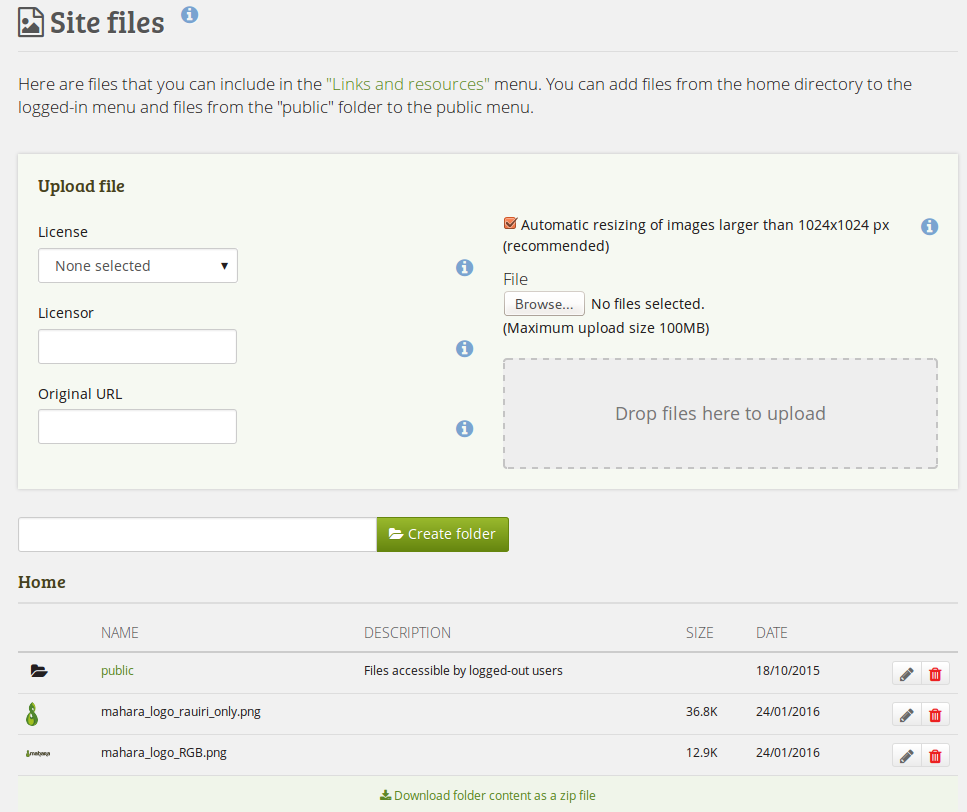
Site files¶
